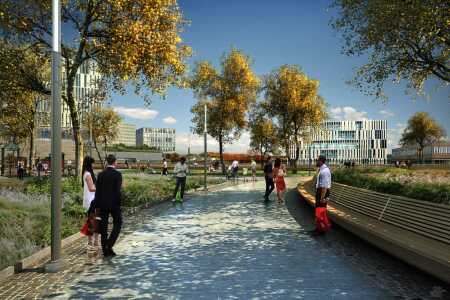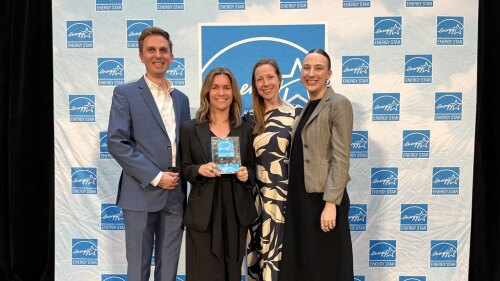
Malvern, Pennsylvania–based Liberty Property Trust is planning a 16-acre (6.5 ha) development along the Camden waterfront that will include 1.4 million to 1.5 million square feet (130,000–140,000 sq m) of Class A office space, as well as 210 residential units and a 130- to 150-room hotel. The site, master planned by Robert A.M. Stern Architects and Michael Van Valkenburgh Architects, will be developed over a three- to four-year period. (Volley for Robert A. M. Stern Architects)
When developer Carl E. Dranoff first drove across the Ben Franklin Bridge to the Camden, New Jersey, waterfront to view a possible site for luxury housing, he was dumbfounded. Spread before him were 20 acres (8 ha) of beautiful, flat, undeveloped land directly across from downtown Philadelphia with stunning views of the city’s skyline.
“A giant red-brick structure that had been vacant for over ten years—RCA Victor Building Number 17—dominated the waterfront,” recalls the chief executive officer of Philadelphia-based Dranoff Properties. “Next to the boarded-up building, I saw tracks being laid for a new light-rail system with two stations. I saw the adjacent campus of Rutgers–Camden with 7,000 students and the growing nearby colossus of Cooper Hospital, the city’s largest employer and now a full-fledged teaching hospital rivaling the great institutions across the river in Philadelphia. I saw a structure perfectly suited for historic conversion—a big, brawny building with huge windows, high ceilings, and amazing architectural details. I saw the beginnings of the Victor—341 apartments plus retail and parking.”
That was 1999, and Dranoff envisioned a Jersey City/Hoboken–type waterfront development with his planned residential historic renovation, the Victor, being the catalyst for a potential two-decade buildout. “I wondered,” remembers Dranoff, “am I crazy or is everyone else?”
Dranoff was not crazy. He was merely early to the transformation of one of the nation’s poorest and most dangerous cities. Seventeen years after that trip across the Ben Franklin Bridge, Dranoff’s vision is being realized. Today, Camden, which in 2012 claimed the highest murder rate in America, is experiencing a rebirth, with some $2 billion in new development planned or under construction. Those projects include the following:
Liberty Property Trust’s 16-acre (6.5 ha) Camden Waterfront development master planned by Robert A.M. Stern Architects and Michael Van Valkenburgh Architects, along the Delaware River waterfront. It will include 1.4 million to 1.5 million square feet (130,000–139,000 sq m) of Class A office space in four office buildings, 210 residential units, a 130- to 150-room hotel, and 4,300 parking spaces.

Brandywine Realty Trust began development of its mixed-use, master-planned community Knights Crossing last year with construction of Subaru’s North American headquarters. The Subaru project consists of a 250,000-square-foot (23,000 sq m) build-to-suit headquarters building and an 83,000-square-foot (8,000 sq m) training center, both scheduled for completion by the end of 2017. (Cooper Robertson)
“Stern’s master plan calls for significant open space and ancillary retail to go along with the other elements,” says John S. Gattuso, senior vice president and regional director of Liberty Property Trust, a Malvern, Pennsylvania, real estate investment trust (REIT). “It will be developed over a three- to four-year period—some construction is anticipated to begin later this year—and will provide connectivity between elements on the waterfront and set the stage for continuing development in downtown Camden.”
Subaru of America’s new $118 million corporate headquarters in Campbell Soup Company’s 77-acre (31 ha) mixed-use master-planned community, Knights Crossing, is under construction. Developed by the Radnor, Pennsylvania–based REIT Brandywine Realty Trust, the urban town-center community ultimately will include 1.5 million square feet (139,000 sq m) of trophy office space, highly accessible from the highway, as well as multiple linked parks, open spaces, and bike and pedestrian trails.
“Knights Crossing will be a significant catalyst to the renaissance taking place in Camden,” says Brian Berson, vice president of development at Brandywine. “The partnership between the state of New Jersey, the city of Camden, Campbell’s, Subaru, and Brandywine sends a clear message that the city is moving forward and that the Camden of tomorrow will be a much different place than the Camden of today.”
The expansion of the Cooper Health Sciences campus continues. The Roberts Pavilion, a $220 million, 312,000-square-foot (29,000 sq m), ten-story patient facility with a dozen new operating-room suites and 60 private medical/surgical rooms, opened in 2008. Four years later, the Cooper Medical School of Rowan University, a partnership of Rowan University and Cooper University Health Care, became the first new medical school in New Jersey in over 35 years. That was followed 12 months later by the new 103,000-square-foot (10,000 sq m), four-story MD Anderson Cancer Center at Cooper, a partnership between Cooper University Health Care and Houston’s MD Anderson Cancer Center.
“There has been a groundswell of economic and redevelopment activity on many fronts, a reduction in crime and poverty, and improvements in education and housing in the city,” says George E. Norcross III, head of the Cooper University Hospital board. “Based on these incremental successes, Camden is well on its way to becoming a thriving business hub. Equally important, Camden is also becoming a better place to live.”
Philadelphia-based AthenianRazak has two projects under development in Camden—the Philadelphia 76ers training center and corporate offices, and the Ruby Match Factory. The NBA basketball team is moving its corporate offices to Camden from Philadelphia, says Alan Razak, principal at AthenianRazak, bringing at least 250 jobs to the Camden waterfront when the 125,000-square-foot (12,000 sq m) facility is completed in September.
A few blocks north of the 76ers facility is the Ruby Match Factory, the speculative redevelopment of a historic loft warehouse into office space in one of the few remaining notable industrial buildings on the waterfront, Razak says. His firm is converting 47,000 square feet (4,000 sq m) of raw warehouse space into about 74,000 square feet (7,000 sq m) of technology-driven collaborative loft office space, “with plenty of historic elements, from bricks to windows to heavy timber trusses,” he says.
Jobs and Investment

Dranoff Properties is planning Radio Lofts, a residential community on the Camden waterfront next to the Victor. A historically significant RCA Victor building, the ten-story structure is expected to be transformed into 86 luxury loft condominiums. Construction is to begin in mid-2017, with completion planned the following year. (Dranoff Properties)
Two things prompted the development surge in a city that had been shunned by the corporate world for decades. First, Camden, under the stewardship of Mayor Dana L. Redd, elected in 2010, has dramatically improved safety and education, and works closely with the development community. Second, and perhaps more important, the city has implemented tax incentives for development.
According to Timothy J. Lizura, president and chief operating officer of the New Jersey Economic Development Authority (EDA), 16 projects in Camden totaling $1.4 billion over ten years have been approved for tax credits.
“These projects are associated with private investment of $1.1 billion, the expected creation of 1,378 new jobs and 4,056 constructions jobs, and the retention of 2,466 jobs, many of which would be new to Camden,” Lizura says. He notes that before any tax credits are approved, projects must comply with program requirements that include generating new tax revenue, completing capital investments, and the hiring or retention of employees.
The tax incentives have succeeded in attracting jobs, says residential developer Dranoff. “The incentives are a catalyst because housing and retail follow jobs,” he says. “While the job growth in Camden’s recent past has been up and down and very inconsistent, the new incentives have been the tipping point in attracting Liberty Property Trust and Brandywine and others to invest massively in the city’s future.”
Decades ago, Camden seemed to have a bright future. Located between the Delaware and Cooper rivers and near Philadelphia, the city was not always the poorest and most dangerous metropolitan area in New Jersey. In the 20th century, Camden was an immense industrial hub. Companies with operations in the area included Campbell’s Soup; American innovation icon RCA (which popularized radio in the 1920s and help develop television in the 1930s); Philco, a pioneer in battery, radio, and television production; and New York Shipbuilding, and they helped make Camden a major presence along the East Coast. But as the years went by, the economy changed. Companies started downsizing and leaving Camden for other, less costly locations in the 1970s, beginning the city’s decades-long decline.
Over the past 40 years, numerous efforts have been announced to transform Camden, with decidedly mixed results. Previous efforts focused on potential magnet attractions such as an aquarium, a bank center, or a ballpark, says Razak. “These were individual islands that couldn’t by themselves create a vibrant urban environment,” he says. “This time, the planning is very focused on creating an urban core with critical mass, with everyday uses, and the mixture of space types that go with them.”
Equally important, past revitalization initiatives in Camden did not fully factor in or address the city’s socioeconomic problems in meaningful ways, says Norcross. “Efforts didn’t take into account, for example, how the educational system wasn’t fully preparing future generations for success, or how a high crime rate affected neighborhoods and the ability to attract new businesses,” he says. “There is a more holistic approach today. To be successful, new projects need to consider how they fit into the broader community and how they add value, rather than just standing alone. Today, Camden has an unprecedented level of cooperation between major institutional anchors not often found in many cities.”
A lot of the credit is given to elected officials. Mayor Redd early on recognized the importance of addressing some of the longstanding issues that have plagued Camden—lack of public safety, neighborhood blight, and the city’s sometimes rocky finances. Redd’s administration undertook an all-inclusive approach to transforming the city, not focusing solely on development, but instead addressing the numerous issues that contribute to improving the quality of life.
“Our strategy has focused on improving public safety; providing academic choices for our students by offering quality magnet, charter, renaissance, and public schools; reducing truancy; creating pathways to real job opportunities for residents; and attracting new business investment, among other initiatives,” she says. “All of the issues are interconnected and impact one another.”

Philadelphia’s AthenianRazak is converting the historic Ruby Match Factory warehouse in Camden to flexible, open loft office space, a project expected to be completed ten months after the first lease is signed. The cavernous space was constructed around 1891; renovation plans include inserting two new mezzanine floors and replacing 200 bricked- and boarded-over openings with large, original-sized windows. (Elmer Design)
Reducing Crime
Redd’s approach soon gained traction. In 2012, 67 murders took place in the city, earning Camden the label “murder capital of America.” Since then, according to statistics compiled by the strategic analysis unit of the Camden County Police Department, the city’s murder rate has declined 52 percent. Over the same period, robberies are off 36 percent and total violent crime is down 23 percent.

One of the first developments along Camden’s waterfront was Dranoff Properties’ six-story Victor Lofts. The building, originally completed in 1917, was the headquarters of the Victor Talking Machine Company, which was sold to RCA in 1929. Vacant for decades, the building in 2004 became the 341-unit Victor, a commercial and residential venture of Dranoff Properties. (Don Pearse)
A major reason for the improvement: the city eliminated its police force in 2013 and replaced it with a new one run by the county. Without costly and cumbersome union work rules, the new force could hire more officers for the same budget and employ civilians to use crime-fighting technology it had never had the staff to handle. More important, officers have been moved from desk jobs and squad cars to the streets, in what Police Chief J. Scott Thomson likens to a community organizing campaign to overcome years of residents’ mistrust and allow police to work more closely with the community.
Thomson notes that the Camden County Police Department has made significant progress by combining human contact, like officers walking beats, with cutting-edge technology that provides officers with real-time intelligence so they can make more informed decisions. “We definitely have made an impact in Camden’s nine square miles [23 sq km],” Thomson says, “but we are still working every shift of every day to improve the community and reduce the number of crime victims. Our priorities are to ensure that children can play in the parks and that residents can walk to the corner store without the threat of violence. This, in turn, will encourage further investment in Camden.”
Making Camden a safer place has also made it a more attractive place to relocate. So has New Jersey’s Economic Opportunity Act (EOA), which provides incentives for private sector employers to relocate employees and businesses to the city.
The law put Camden in a more competitive position, explains Norcross. “In the past, Camden may have missed some opportunities because projects were lured to other locations with more favorable incentives,” says Norcross. “That’s changed. In addition, New Jersey’s Economic Development Authority has used its resources throughout the state to help not-for-profit organizations seeking capital to expand community services, municipalities looking to attract major corporations to their area, and developers requiring funds for a major redevelopment project.”
Tax Credits
The EDA assistance in obtaining access to capital—including tax-exempt and taxable bond financing, loans, loan guarantees, and business and tax incentives—has benefited many companies seeking to expand in or relocate to Camden. The tax credits offered are generous and extremely potent, judged by how many jobs are created, says Dranoff.
“They are especially helpful in office development,” he says. “Residential projects are able to secure a 20-year tax abatement—ten years full abatement, then graduated for the next ten years.
Thanks to these incentives, we are planning a new ground-up, 150-unit multifamily project adjacent to the Victor and at the same time are converting the historic Radio Lofts building [RCA Building Number 8] into loft office space.”
Gattuso of Liberty Property Trust also cites the state’s tax incentives. “They are very significant credits; up to 100 percent of an investment can be taken as a tax credit,” he says. “A qualified company, for example, that invests $100 million in a facility can receive $100 million in tax credits for their tax liability over ten years. That has attracted the interest of the development community.”
Some argue that the state’s incentives may be a little too generous. Gordon MacInnes, president of New Jersey Policy Perspective, a liberal think tank based in Trenton, questions whether providing such vast incentive programs is the best strategy to spur job creation in the state’s most beleaguered urban center.
“The economic benefits of these incentives are extravagant and unusual,” says MacInnes. “It’s not a good way to generate investment in New Jersey since many of the firms who have obtained incentives have only made intrastate relocations.” Two companies that received millions in tax credits—Subaru from Cherry Hill and Holtec International, a global supplier of equipment and systems to the energy industry, from Marlton—moved from about ten miles (16 km) away, he says. “The 76ers relocated to Camden from Philadelphia across the river, but the vast majority of those jobs are already filled.”

One of the first developments along Camden’s waterfront was Dranoff Properties’ six-story Victor Lofts. The building, originally completed in 1917, was the headquarters of the Victor Talking Machine Company, which was sold to RCA in 1929. Vacant for decades, the building in 2004 became the 341-unit Victor, a commercial and residential venture of Dranoff Properties. (Don Pearse)
While he respects what the state, county, and city are trying to accomplish, MacInnes says the incentives being awarded simply do not square with conventional, prudent investment practices.
“The state is making deals with companies that are free to leave after 15 years, even though the benefits were calculated on the firms being there for 35 years,” he says. “The benefits of using these types of incentives to lure businesses to Camden and other cities are dicey at best.”
Real estate entrepreneurs say substantial incentives are needed because underwriting in a redevelopment area is a challenge for many banks. “It wasn’t until the New Jersey credits came along that real activity in Camden started to happen,” says Razak. “Even with massive subsidies—which only last a few years—making long-term bets in a largely untested location like Camden poses a lot of risk. It takes a financial institution with some vision to evaluate those risks and say, ‘Yes, we’ll do it.’ That by itself may not sound very innovative, but it actually is. For our Ruby Match Factory project, we assembled all of these tools to make the numbers work to help fill in the gaps in traditional financing. Our project wouldn’t fly with just a traditional debt/equity structure.”
When AthenianRazak started working with the 76ers, the sports organization planned to locate its new facility near Philadelphia’s Navy Yard. Then Razak alerted the 76ers to the New Jersey tax credits. “The incentives were too good to pass up,” says Razak. “The owners were awarded $83 million in tax credits for the project and were among the first major users to announce a relocation to Camden. Their initial plans called for an innovative but modest facility, but the support provided by the Grow NJ tax incentive program allowed the 76ers to reach for a much higher standard.”
The use of innovative financing was one of the main reasons all the construction took place in Camden, Berson says. “The creative element to the innovative financing is the ability for the end user to own rather than lease their facility, having financed/paid for it through the EDA tax incentives,” he says. “We have never seen this level of incentives before. But once the tax credits burn off, development will still be successful and businesses will thrive. Camden will be left a legitimate and attractive submarket for the regional business community.”
Mike Sheridan is a freelance writer in Parsippany, New Jersey.





![Western Plaza Improvements [1].jpg](https://cdn-ul.uli.org/dims4/default/15205ec/2147483647/strip/true/crop/1919x1078+0+0/resize/500x281!/quality/90/?url=https%3A%2F%2Fk2-prod-uli.s3.us-east-1.amazonaws.com%2Fbrightspot%2Fb4%2Ffa%2F5da7da1e442091ea01b5d8724354%2Fwestern-plaza-improvements-1.jpg)